Humphrey Bogart and Peter Lorre, The Maltese Falcon, 1941
a
The Usual Suspects:
Early on during the first few weeks of this blog, I had the idea to start a section where I would write about some of Bogart’s more regular collaborators and costars – actors, directors, writers, etc. – that worked with him on multiple films. Given the contract system of the movie studios, casts and crews often overlapped from one film to another. Character actor Eddy Chandler, for instance, costarred in thirteen different pictures with Bogart, almost exclusively in tiny bit parts, often uncredited. But there were also those artists that Bogart had deep personal friendships with, and sometimes, strong working relationships – people that often appeared repeatedly by choice, supporting Hollywood’s most famous leading man to make some of the greatest films in cinema history.
Dubbed The Usual Suspects, this first post is in response to the “Dynamic Duos” Blogathon over at Classic Movie Hub (@ClassicMovieHub) and Once Upon a Screen (@CitizenScreen). What better way to begin, I thought, than by kicking it off with one of Bogie’s most famous costars and close friends, Peter Lorre.
The Man
Born in Rózsahegy, Hungary, László Löwenstein began his acting career by sacrificing everything he had in life to devote himself to the theater, eventually moving to Germany to study under playwright Bertolt Brecht. Brecht latched onto Lorre right away and knew how to use him, bringing the unique looking actor much acclaim during their long and productive collaboration together. Adopting the stage name Peter Lorre in 1925, Lowenstein received his big break in the starring role of his second movie, playing a child murderer in Fritz Lang’s M.
When the Nazis fully took power of Germany in 1933, Lorre left, traveling Europe and eventually arriving at London. His performance in M got him noticed by director Alfred Hitchcock and led to a role in Hitchcock’s film The Man Who Knew Too Much. After working with Hitchcock, Lorre would make his move to Hollywood where he found great success with his unique look and soft speech pattern playing an assortment of bad guys and shady characters.
Lorre would go on to star in the Mr. Moto movie series in which he played a Japanese detective in eight different films. He also became a longtime collaborator with actor Sydney Greenstreet, making nine films with the English stage legend.
Lorre is perhaps best known, though, as the five-time costar and good friend of Humphrey Bogart. Working together on some of Hollywood’s most legendary classic films, Bogart and Lorre left behind some great stories of onset pranks, drinking revelry, and a deep friendship that reverberate through Hollywood lore to this day.
It was at Lorre’s house where Bogart would sleep off many a drunk night rather than go home to face his third wife, Mayo Methot. It was also at Lorre’s ranch where Bogart and Lauren Bacall would hideaway for weekend rendezvous when they needed to stay out of the limelight as they courted. And perhaps most famously, it was Lorre who gave this advice when Bogart fretted that he was too old for Lauren Bacall – “Five good years are better than none!”
THE FILMOGRAPHY
The Maltese Falcon – 1941
Lorre plays Joel Cairo, an associate of Sydney Greenstreet’s Kasper ‘The Fatman’ Gutman. Both men make attempts to hire Sam Spade (Humprhey Bogart) to acquire a valuable jewel-encrusted falcon statue – perhaps the most famous cinema ‘MacGuffin’ of all time. Cairo, who’s portrayed overtly gay in the novel on which the film is based, has his homosexuality toned down considerably in this film due to the Hay’s Code of film censorship. Instead of direct references, Cairo’s sexuality is inferred through his effeminate fussiness, and occasional physicalities with his cane:
Reportedly, the cast and crew got along very well during the filming of this movie, and would go out for drinks at the end of the day as they were often ahead of production schedule. They were also a very close knit and private group, unappreciative of outside influence either from the studio or the public. One particularly famous story relates that one of the main actors, either Bogart or Lorre, played a joke on a visiting women’s club as they walked by the set. One of the two actors supposedly exited Mary Astor’s trailer, zipping up his fly, and calling out “Bye, Mary!” A. M. Sperber credits the story as happening to Lorre in her Bogart bio, Bogart (p 160), while Stefan Kanfer names Bogart as the perpetrator in his Bogart bio, Tough Without a Gun (p 65). Neither author cites specifically where they got the story, but I suppose what’s most important is not the actual culprit, but the reputation that the cast had earned as ornery tricksters and close friends.
All Through the Night – 1942
Lorre plays Pepi, the Nazi hitman and sometimes piano accompanist to Kaaren Verne’s Leda Hamilton. Pepi kicks off the storyline by murdering “Gloves” Donahue’s (Humphrey Bogart) favorite cheesecake baker, setting off a chain of events that leads New York’s most notorious gangsters up against the Third Reich in this comedy thriller.
Lorre enters the film walking through the door of a baker’s shop, eerily humming a tune before teasing the poor baker and then beating him to death. Referred to as “the goggle-eyed little rat,” by ‘Gloves,’ Lorre is wonderful, and one of the true highlights of the film. Only two actors are capable of smoking in such a way as to defy gravity – Lorre and Bogart – as their cigarettes dangle at an impossible 90 degree angle from their lips.
Karen Verne would go on to leave her husband for Lorre, becoming Lorre’s second wife, although their marriage would prove to be tumultuous and short lived.
Casablanca – 1942
Lorre plays Ugarte, a black marketeer who hides valuable letters of transit with Bogart’s Rick Blaine before being arrested by the police. Ugarte’s plan is to sell the papers for a small fortune in order to pay for his escape from Casablanca. His relationship with Blaine seems to be one of mutual loathing and respect. They don’t necessarily like each other, but they occasionally find one another valuable.
Just before giving Blaine the transit papers, Ugarte tells him “You know, Rick, I have many a friend in Casablanca, but somehow, just because you despise me, you are the only one I trust.” Blaine tells Ugarte that he’ll hold the papers for him, but doesn’t want them in his nightclub overnight. We then get perhaps the most ominous moment in the film when Ugarte lightly puts his hands upon the papers and gently tells Rick “Don’t be afraid of them. . .” The papers are Casablanca’s ‘MacGuffin,’ and once again Peter Lorre is here to play a hand in the treasured objects of fate. Men died for Ugarte to obtain the papers, and more people would die before they are finally used. As the objects of everyone’s desires, even Blaine himself contemplates stealing the papers to run away with Ilsa.
Lorre’s part in the movie was small and shot so quickly that he had no idea how much the role would go on to help define his place in cinema history. On the set, he supposedly carried a hidden dropper of water that he would use to extinguish Director Michael Curtiz’s cigarette with when he wasn’t looking. (Kanfer, 79)
Passage to Marseille – 1944
Lorre plays Marius, one of Bogart’s fellow escaped convicts from Devil’s Island. I found this to be one of Lorre’s most likable roles, as he’s a full-on action partner to Bogart in the film, teaming up to both escape from prison, and then later to take down a Nazi bomber as it attacks their ship. Seeing both men take their shots at the German plane with machine guns, occasionally stopping to wave to one another and smile, is one of my favorite moments in Bogart / Lorre cinema history.
There’s a lot of delight to be had watching both men squint, smoke, and plot together as they make their way back to France. This is the only film out of the five in which they are on completely friendly terms, and their chemistry is superb.
As the story goes, Bogart and Lorre took great fun in pranking Director Michael Curtiz on the set. Both would take turns stalling shots as they told long and tedious anecdotes. The monologues would only end when they got a laugh from Curtiz. No laugh from the director meant more jokes and stories from Bogart and Lorre. (Kanfer, 96)
Beat the Devil – 1953
Lorre plays Mr. O’Hara, a member of the criminal ring that’s in league with Bogart to obtain and exploit some African land that’s rich with uranium. Bogart and Director John Huston wanted Lorre on this film as they believed that he was a lucky talisman for Bogart after The Maltese Falcon and Casablanca. (Kanfer, 175) Not to mention the fact that Lorre and Bogart were good drinking friends, and always enjoyed each other’s company. Huston and Bogart asked Lorre to take a significant pay cut in order to keep the budget low, and Lorre accepted the role in order to work with a good friend.
Lorre’s costar, Robert Morley, on the other hand, considered Lorre to be “an intensely tiresome little chap with quite the foulest vocabulary I have ever had the misfortune to listen to.” (Kanfer, 178)
Sporting some extra weight and a short crop of blond hair, Lorre is great as the smooth-talking little crook that is excited for the swindle, but always ready to cower behind one of the other criminals if things look rough.
If you haven’t seen it in a while, the film is a lot of fun, and it’s great to hear Lorre’s distinctive speech pattern saying lines written by scriptwriter Truman Capote:
O’Hara: “Time, time, what is it? The Swiss manufacture it, the French hoard it, Italians want it, Americans say it’s money, Hindus say it does not exist. You know what I say? I say time is a crook.”
Truer words were never spoken as you consider the fact that this was the last pairing of the two great Classic Hollywood actors.
In Closing
Five films. All of them are classics in their own right. One of them is considered by many to be the greatest film of all time. The friendship and working relationship of Humphrey Bogart and Peter Lorre has etched a large and permanent mark onto the landscape of cinema history. Powerfully gifted apart, but even greater together, I can’t think of a better duo to kick off the inaugural post for The Usual Suspects portion of this blog.
Bonus Lorre Facts:
He was the very first actor to play a bond villain when he portrayed Le Chiffre in the 1954 TV version of Casino Royale!
When asked by the House Un-American Activities Committee to name the names of anyone he considered suspicious and possibly a communist, Lorre gave them a list of everyone he knew. The same group would go on to assemble a thick file on Bogart and cause him considerable mental turmoil over the years despite the fact that he was a diehard U.S. patriot.
The Boo Berry ghost mascot from General Mills was inspired by Lorre.
*All research for this post was done with Stephen D. Youngkin’s Peter Lorre biography, The Lost One: A Life of Peter Lorre, A. M. Sperber’s Humphrey Bogart biography, Bogart, Stefan Kanfer’s Humphrey Bogart biography, Tough Without a Gun, Peter Lorre’s Wikipedia page, The Maltese Falcon’s Wikipedia page, the official website of The Humphrey Bogart Estate, and various movie entries on IMDB. All screen caps were done by the author and are intended for review/criticism of the films mentioned. Any portion of this post that could not be correlated with at least one other source is credited specifically within the post.

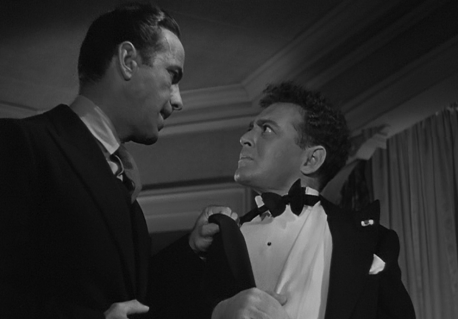
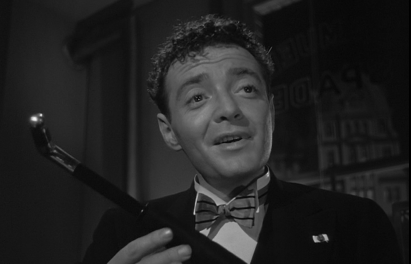
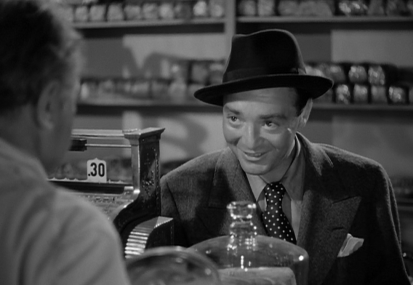
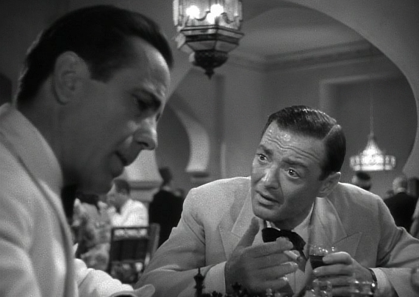
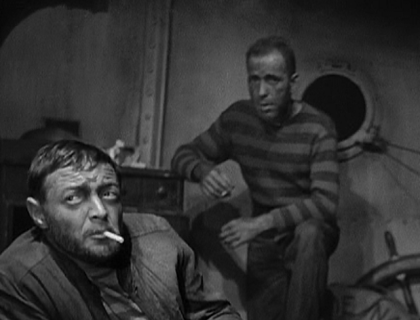

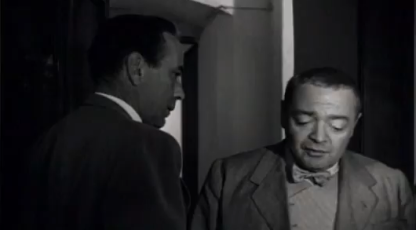
I have only seen the Lorre/Bogart combo in Casablanca and The Maltese Falcon, but in each instance their relationship has been a highlight of the film. I plan to check the other works out, because after initially seeing Lorre in Fritz Lang’s M I cannot get enough of his acting.
Oh, man! If you like their chemistry, you should definitely check out Passage to Marseille! Thanks for stopping by!
Pingback: Schedule: DYNAMIC DUOS in Classic Film blogathon | Once upon a screen...
As a long-time Peter Lorre fan myself, I really appreciate your highlighting his work with Humphrey Bogart. Good job!
However, I must also point out a few mistakes in the Lorre biography section of your post.
Peter made only one movie before “M” — a silent film in 1929 called “The Missing Wife”. Peter headed to Hollywood, with his wife Celia Lovsky, immediately following work on “The Man Who Knew Too Much”. His work in “M” led to attention from Hollywood movie studios — even though “M” was not widely released in the U.S. When he left for Hollywood, he had an excellent command of English, a language he had learned just before starting work on the Hitchcock movie and with the help of an English tutor. Peter also translated into German all of his English dialogue, enabling him to understand what he was saying, rather than “parroting” his lines.
You can learn more about Peter in the authorized Lorre biography — “The Lost One: A Life of Peter Lorre”, by Stephen D. Youngkin. The book contains a lot of information on the friendship of Peter and Bogie, including interviews with some of the directors — John Huston and Vincent Sherman — who worked with them. Or you can visit the book’s official website — http://www.peterlorrebook.com — which in addition to information about the book includes a biographical sketch on Peter, as well as numerous photos, sections on Peter’s radio shows, and DVDs of his film and TV work.
Thanks again for thinking of Peter in your series!
Cheryl!
Thanks for the great info! I’m on vacation this week, but will be ordering that book as soon as I’m home! I adjusted the timeline a bit to reflect your comments, and removed the “learning English phonetically” section, although I have that listed from two separate sources. As far as the filmography is concerned, multiple sources have three films listed before M – Die Verschwundene Frau (The Missing Wife), The White Devil, and A Man’s a Man. Would that be incorrect? Do the filmographies have them listed out of order, or does he actually not make appearances in them? If I can get a backup source to that I can correct it.
Again, thanks so much, and thanks for the tip on the book! I’m a big Lorre fan and can’t wait to read it!
Glad you have ordered “The Lost One” and that you’re looking forward to reading it. I’m sure you’ll enjoy it very much — especially all the Bogart and Lorre stories.
“The Lost One” is the prime source for a correct list of Peter’s films. Unfortunately, sorces such as Wikipedia and IMDB list movies he was not in — but these errors are difficult to correct. “The Missing Wife” was a silent movie Peter made before “M”, and a movie that he told no one about working on. You’ll read about it and how Peter kept his participation a secret in “The Lost One”. “The White Devil” is a not one of Peter’s movies. His movie is “The White Demon”, which is a different movie. “A Man’s a Man” is a Bertolt Brecht play; apparently someone had a movie camera and filmed a little of the rehearsal — and this event is considered a movie by Wikipedia and IMDB.
I have also seen “In This Our Life” listed as one of Peter’s films. The rumor is that Peter, as well as Bogie, Mary Astor, and Sydney Greenstreet, all made a cameo appearances in the film as some sort of “good luck” charm for John Huston. On “The Lost One” website, you can see frame grabs of the sequence in question — but you won’t see Peter and his “Falcon” co-stars because one of them were in the movie.
Enjoy “The Lost One”!
Great info, Cheryl! Thanks so much! I’m on vacation now and away from my computer, but I’ll make the changes when I get home. As far as In This Our Life, after a lot of searching and screen grabbing, I came to the same conclusion! If it was there, it was cut out. I’ll make sure to link your page and book when I get home!
Cheryl, would you be willing to email me at bogiefilmblog@gmail.com so I could get your email address? I’ve got a question I’d like to ask you.
JUST ordered the book! It should be waiting for me when I get home! Thanks for the tip!
Bogart and Lorre make a great combination – I love ‘Passage to Marseille’, but still need to see ‘All Through the Night’ and ‘Beat the Devil’. Great posting, looking forward to reading about more of the ‘Usual Suspects’!
I hope you get to see them both soon! Beat the Devil is in the public domain, so you can watch it almost anywhere, including YouTube. Thanks for stopping by!
wonderful piece of this great relationship! I’ve always been a fan of both actors and it was nice to read about their chemistry! Great contribution to the blogathon-cheers Joey
Thanks, Joey! I appreciate it!
Nice write-up on Peter Lorre. I always enjoyed his acting especially in Arsenic And Old Lace. Great write-ups on these duos by all. I am just dissapointed nobody to a crack at Jack Carson and Dennis Morgan, one of the greatest duos ever.
You should have written it, John!
Pingback: Flynn & Rathbone – the perfect duelists | The Baz
I’m glad to learn more about Peter Lorre…I realized I knew almost nothing about him!
Great tribute to both men — and great stories, too. 🙂
Thanks! And thanks for stopping by!
Bogart and Lorre had wonderful chemistry. It’s a shame they didn’t work on more projects together. I haven’t seen Passage to Marseille or All Through the Night, but I will definitely seek those titles out. Terrific write-up!
Thanks! And for sure you should check them out! Both films are a ton of fun!
FANTASTIC!!! I’m just starting to make the rounds now. 🙂
Love that their friendship was real in a place full of fakes. I’ve seen all of Lorre and Bogart’s collaborations but must re-visit a couple. Love this post – KUDOS! And a terrific addition to the blogathon!
Aurora
Thanks, Aurora! That means a lot!
Very nice facts about Lorre, an actor I truly admire. When he is paired with Bogie, then, for sure something good is going on!
Don’t forget to read my contribution to the blogathon! 🙂
Greetings!
Thanks, Le! I’m making my way through the posts! I was on vacation for the first half of the week, so I’ve got some catching up to do, but I’ll read it! I promise! Thanks for stopping by!
Pingback: Leslie Howard | The Bogie Film Blog
Pingback: » Movie Review – African Queen, The Fernby Films
Pingback: The Maltese Falcon: Humphrey Bogart as Samuel Spade | Girls Do Film
I remember a scene with Greenstreet seated and Lorre standing by the door of a black Citroen.
The only lighting was a single street lamp and Lorre’s cigarette. Anyone remember which film or where the scene was set?
Pingback: The 15 Greatest Humphrey Bogart Movie Moments | Fishstream TV